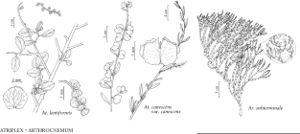Atriplex canescens var. canescens
Plants mainly 8–20 dm, not especially armed, not or seldom layering. Pistillate flowers borne in panicles 5–40 cm. Fruiting bracteoles with stipes 1–8, body with 4 prominent, dentate to entire wings extending length of bract, united throughout, mainly 8–12 mm wide and about as long, apex toothed, surface of wings and body smooth or reticulate. 2n = 36+.
Phenology: Flowering spring–fall.
Habitat: Sandy or gravelly, commonly non-saline but in other situations obviously saline, sites in Joshua tree, blackbrush, greasewood, salt desert shrub, sagebrush, mountain brush, and pinyon-juniper communities
Elevation: 100-2400 m
Distribution

Alta., Ariz., Calif., Colo., Idaho, Kans., Mont., Nebr., Nev., N.Mex., N.Dak., Okla., Oreg., S.Dak., Tex., Utah, Wash., Wyo., Mexico
Discussion
Narrow-leaved material from west Texas formed the basis of Atriplex canescens var. angustifolia. The nature of such narrow-leaved phases requires additional research. Probably the Texas plants having narrow leaves originated quite separately of other narrow-leaved phases.
Selected References
None.
Lower Taxa
"wide" is not a number."united" is not a number.
